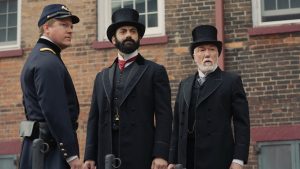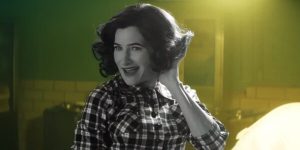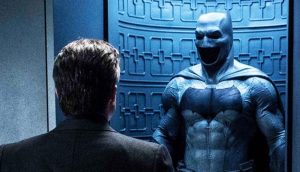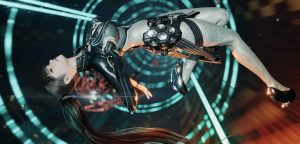
Warning: contains plot spoilers for The Boy and the Heron.
The English-language title of Hayao Miyazaki’s latest feature at Studio Ghibli is misleadingly simple. The Boy and the Heron suggests an Aesop-like fable in the vein of The Ant and the Grasshopper, or The Hare and the Fox. The film itself has nothing like the clarity of a fable. It’s crowded, at times to the point of narrative incoherence, with enchanting but mystifying episodes that elude a single reading.
It’s the story of Mahito, a boy in 1940s Tokyo who loses his mother in a wartime fire. A year later, his father remarries her sister and starts a new family, moving them out to the aunt’s childhood countryside home. There, Mahito is plagued by a menacing heron who lures him to a mysterious tower built by his grand-uncle with the promise of seeing his mother alive. When Mahito’s pregnant aunt/step-mother disappears into the tower, he follows and has a series of mystifying and dangerous adventures before eventually meeting the master of the realm – his grand-uncle – who offers him the chance to inherit his mystical world-making role. Mahito refuses and returns to the normal world with his aunt, the tower collapses, and a year or two later, the family leave the house behind.
The Japanese title, which translates as How Do You Live? (taken from Genzaburo Yoshino’s 1937 novel, of which this is in no real way an adaptation) is a much better fit for the film’s exploratory nature. One reading is that the 83-year-old director is asking himself that very question through this fantastical story. How do you live? How has he lived? And approaching its end, what does an artist’s life amount to?
That’s one reading of many into this inventive, kaleidoscopic film. From a fictionalised version of Miyazaki’s childhood and his relationship with his fellow animators, to an allegory for Studio Ghibli and its future after Miyazaki’s retirement, to its slippery connections with the book from which it takes its original name, let’s dig into the theories.
What Does It Have to Do With the Book “How Do You Live?”
Genzaburo Yoshino’s 1937 Japanese classic is reported to have been one of Miyazaki’s favourites as a child, and a copy of it inscribed to Mahito from his mother features in the film that bears its title in Japanese. Between the actual book and the film though, there is very little crossover.
The story is that of an academic 15-year-old boy named Koperu/Copper whose father died when he was younger, and who lives with his mother. The narrative includes Koperu’s ongoing discussions with his uncle about ethics and morality, interspersed by the uncle’s diary entries as he prompts his nephew to consider the life he will lead. According to fantasy author Neil Gaiman’s foreword for the 2023 Penguin edition, Copper and his uncle are: “…our guides in science, in ethics, in thinking. And on the way they take us, through a school story set in Japan in 1937, to the heart of the questions we need to ask ourselves about the way we live our lives.”
There’s nothing though, about a heron, a mystical tower at the crossroads of time and space, people-eating parakeets, soul-eating pelicans, or a fire witch, so don’t be disappointed if you look this one up.
How Autobiographical Is the Film?
Almost nothing was known about The Boy and the Heron save its title and poster until release weekend in Japan – a marketing strategy that clearly paid off when the film became Studio Ghibli’s biggest domestic opening of all time, and topped the US box-office on its American release.
A marketing message that did break through, thanks largely to multiple press interviews by producer Toshio Suzuki and lead animator Takeshi Honda, was the film’s autobiographical nature. As Honda told The Ringer (through an interpreter), when Miyazaki showed him the initial part of his legendary storyboards, “I instantly could tell that it was a very personal story to him and it was very autobiographical.” But in what way?
Despite several reviews of the film, including Vanity Fair’s, claiming that its protagonist Mahito “comes of age during World War II (much like Miyazaki himself did)”, Hayao Miyazaki wasn’t born until 1941, making him several years younger than Mahito, whom we first meet around the age of 10 in 1943.
Other discussions of the film such as this one in The Conversation describe Mahito as symbolising “Miyazaki himself, a child who, having lost his mother and been compelled to leave Tokyo during wartime evacuations, continues to yearn for motherly comfort.”
The film’s traumatic opening in which Mahito runs towards the burning hospital where his mother dies (unforgettably animated by Akira and Spirited Away’s Shinya Ohira) wasn’t Miyazaki’s experience. While it’s true that as a boy, Miyazaki was separated from his mother while she was treated in hospital for tuberculosis, she actually lived until the director was well into his 40s.
The character of Mahito’s father Shoichi, on the other hand, is clearly modelled on Miyazaki’s own father Katsuji. Both were directors of factories that produced aviation parts during the Pacific War, and both enjoyed a level of material wealth during wartime that set them apart from their peers. When Mahito is driven to his rural school in a motorcar, it isolates him from his less well-off schoolmates who are used there for agricultural labour, and leads to an incident of bullying.
While Miyazaki shared Mahito’s experience of leaving a wartime Tokyo for the safety of the countryside when his family was evacuated, and was also separated – though not permanently – from his mother at a young age, as well as having an aviation factory boss as a father, it’s clear that Mahito is not simply a fictional overlay of the director’s actual experiences as a boy, but an emotional one.
So then… is 83-year-old Miyazaki instead to be found in the character of the grand-uncle?
Toshio Suzuki’s Reading: Portraits of Studio Ghibli’s Animators
Studio Ghibli President Toshio Suzuki has repeated his interpretation of the film as an extended metaphor about the past and future of Studio Ghibli itself. Speaking to Entertainment Weekly through an interpreter, Suzuki explains that Mahito’s character “mirrors how Miyazaki is. It’s very autobiographical in that sense. He says that when he was a boy, he was a super introvert.”
According to Suzuki, the character of the grand-uncle represents Studio Ghibli co-founder Isao Takahata: “In Miyazaki’s mind, the old wizard character is Isao Takahata, Miyazaki’s senior animator who actually discovered his talent.”
In the same interview, Suzuki claims that Miyazaki’s favourite character from the film is the Parakeet King, another creation designed to reflect him: “The model of that character is himself: his personality, expressions, and his bearing, as well as what he does and what he says. The relationship between the Granduncle and the Parakeet King is Takahata and Miyazaki.”
Speaking to IndieWire, Suzuki continued to map the film’s characters onto figures in Studio Ghibli history, claiming that the titular heron – initially an antagonist who becomes a guide and ally to Mahito in the fantastical world – is based on himself: “Miyazaki is Mahito, Takahata is the great uncle, and the gray heron is me.”
“So I asked him why. He said [Takahata] discovered his talent and added him to the staff. I think Takahata san was the one who helped him develop his ability. On the other hand, the relationship between the boy and the [heron] is a relationship where they don’t give in to each other, push and pull.”
Suzuki told Deadline that the death of Takahata in 2018 rocked the film’s production schedule, causing Miyazaki to change the focus of the story “from the boy and his great uncle to the relationship between the boy and the heron.”
It’s to be determined how accurate this rather neat and perhaps oversimplistic reading of the film is, but there’s plenty to suggest that the grand-uncle’s tower and his need to find a successor relates to the story of Studio Ghibli itself.
The Crumbling Tower as a Studio Ghibli Metaphor
In the film, the grand-uncle offers Mahito the chance to continue his work as the master of the fantastical realm, and offers him a set of blocks to stack in different configurations that determine the nature of the magical world. He tells Mahito that his successor must come from his own bloodline, which explains why the heron – who works for the grand-uncle – seized on his descendant Mahito to lure inside the tower.
The search for a successor to carry Studio Ghibli forwards following the 2018 death of co-founder Isao Takahata and ‘retirement’ of Hayao Miyazaki (who’s since made this film and is reported to be working on another) is well-known. In September 2023, the Studio announced that a deal had been reached for it to be acquired by Nippon TV, as explained in a statement reported by The Guardian saying: “We have long struggled with the question: who will be the successor”.
In the same statement, Goro Miyazaki, the co-founder’s son, explained that he had rejected the idea of taking on the studio saying, “It is too much to shoulder by myself. It is better to leave it to somebody else.” Goro Miyazaki is a landscape architect and animation director who heads up the studio’s museum and Ghibli Park projects.
The parallels, if you want to see them, are clear: an offer made to a bloodline descendant, rejected. A fantastic world determined by the building-block choices of the creator at its centre, who must devote his life not only to keeping it in existence, but also to ensuring his choices create joy and stability instead of pain.
During production, Toshio Suzuki reportedly described The Boy and the Heron as a legacy in itself, and intended for Miyazaki’s grandson as a way of saying “Grandpa is moving onto the next world soon but he is leaving behind this film.”
Perhaps the best advice for interpreting this endlessly inventive picture comes from the film’s composer Joe Hisaishi, a longtime Studio Ghibli and Miyazaki collaborator. Speaking to LA Times, Hisaishi suggests “to not search for real meaning in the film but to just let yourself feel it. I think that will end up being a much happier experience.” Sound advice.
The Boy and the Heron is out in cinemas now.
The post What Does The Boy and the Heron Mean? Exploring the Theories appeared first on Den of Geek.







